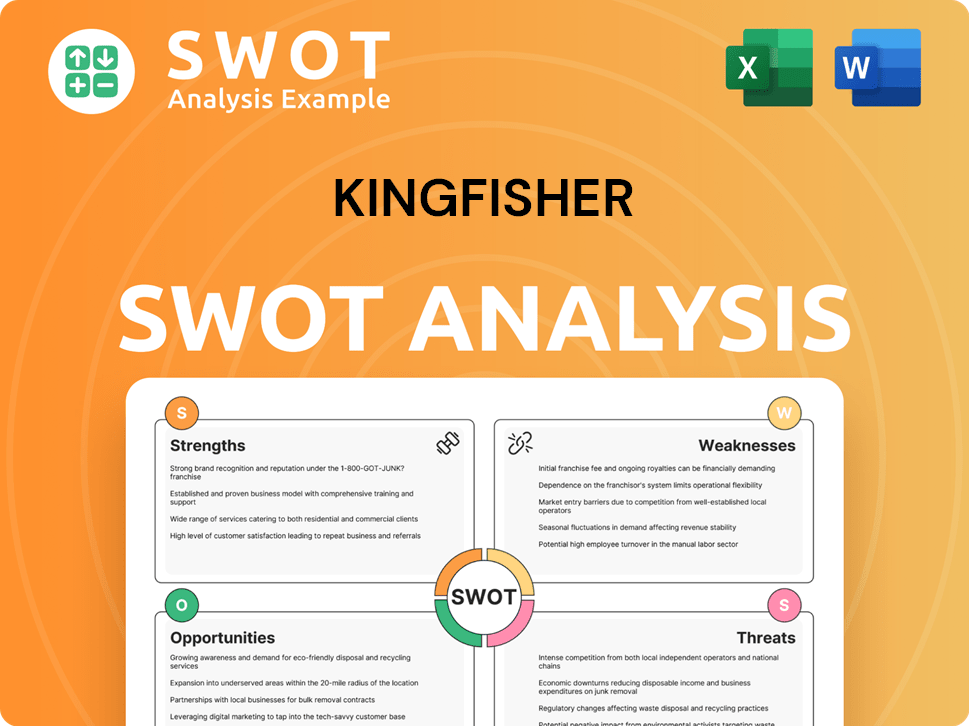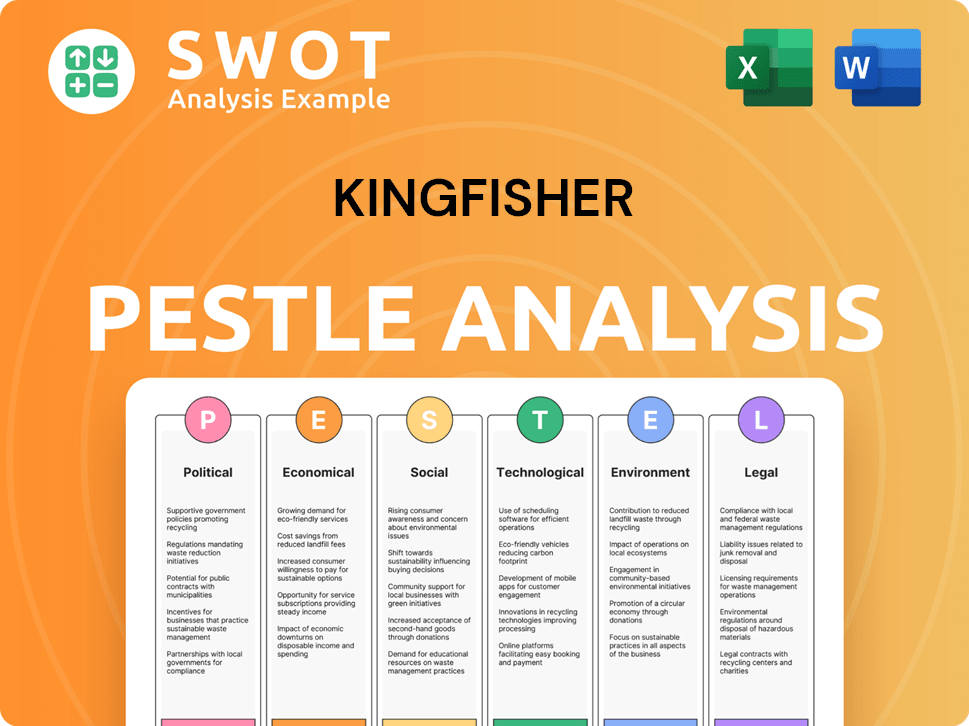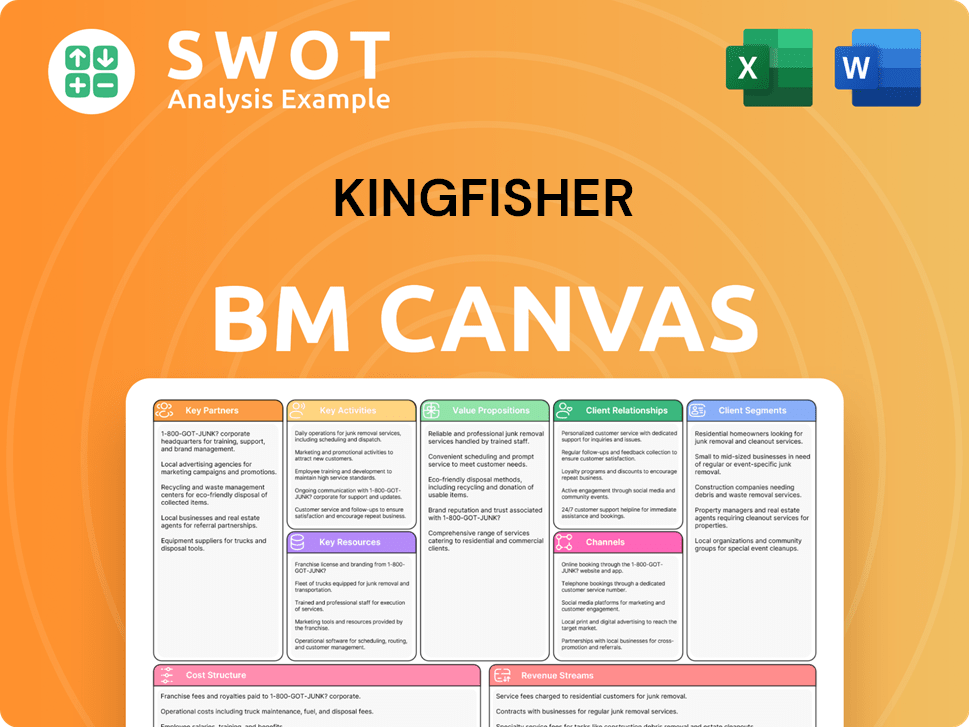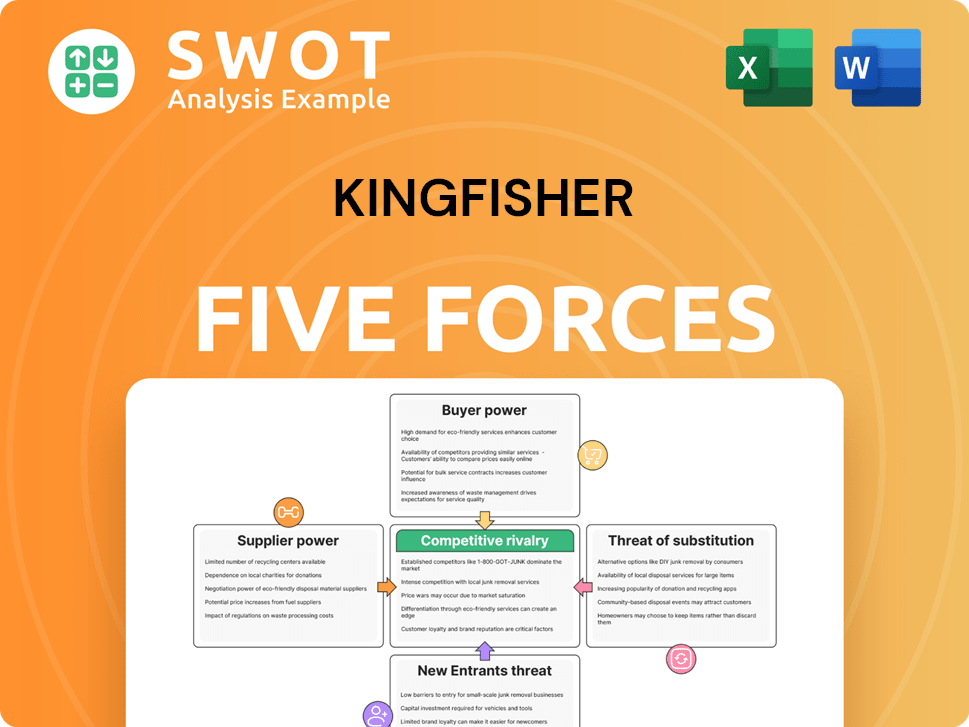Kingfisher Bundle
How Does Kingfisher Thrive in the Home Improvement Market?
Kingfisher, a leading international home improvement company, boasts a significant presence in Europe and beyond. With a market capitalization of $5.51 billion as of May 2025, the company operates over 1,300 Kingfisher SWOT Analysis stores under various retail banners. Understanding the intricate workings of the Kingfisher company is vital for anyone looking to navigate the dynamic retail landscape.

This exploration of the Kingfisher business model will dissect its core Kingfisher operations, revenue streams, and strategic initiatives. We'll examine how Kingfisher sources its products, its expansion strategy, and its competitive advantages within the home improvement sector. This analysis provides a comprehensive view of Kingfisher's financial performance and its approach to sustainability, making it an essential read for investors and industry professionals alike.
What Are the Key Operations Driving Kingfisher’s Success?
The Kingfisher company operates a diverse portfolio of home improvement retail banners, including B&Q and Screwfix in the UK and Ireland, and Castorama and Brico Dépôt in France and Poland. These banners cater to various customer segments, from DIY enthusiasts to trade professionals, offering a wide array of home improvement products and services. This multi-brand strategy allows the company to target different market niches effectively.
The core operations of Kingfisher include manufacturing, sourcing, technology development, and logistics, all supported by a strong omnichannel presence. The company focuses on its own exclusive brands (OEB), which accounted for 45% of sales. This strategy aims to provide differentiation and higher gross margins compared to branded products. Kingfisher's e-commerce capabilities are also a key focus, with online sales representing 17% of group sales in fiscal 2024.
The Kingfisher business model is built on a foundation of retail operations, with a strong emphasis on both in-store and online sales. The company leverages its extensive store network to facilitate faster order fulfillment and broader product choice, including through its e-commerce marketplace propositions. The supply chain and distribution networks are crucial for efficiency, although challenges have been encountered, particularly in integrating centralized IT platforms across different banners.
The company operates various retail banners, each targeting different customer segments. B&Q and Screwfix focus on the UK and Ireland, while Castorama and Brico Dépôt are prominent in France and Poland. Koçtaş operates in Turkey. This multi-brand strategy enables Kingfisher to cater to a wide range of home improvement needs.
Online sales are a significant growth area for Kingfisher. In fiscal 2024, online sales represented 17% of total group sales, a substantial increase from 8% in fiscal 2019/20. This growth is driven by successful marketplace initiatives across all markets. The company continues to invest in its digital platforms.
Supply chain and distribution are critical to Kingfisher's operations. The company is working to optimize its store footprint and improve logistical efficiencies. Challenges have included integrating IT platforms across different brands. The goal is to enhance the speed and efficiency of product delivery.
Exclusive brands are a key part of Kingfisher's strategy. These brands accounted for 45% of sales, providing differentiation and higher gross margins. The company focuses on developing innovative and sustainable products under its own brands. This helps to control product quality and pricing.
Kingfisher provides simple, innovative, and sustainable home improvement solutions at affordable prices. Its market differentiation stems from its retail banner diversity, combined with the scale and expertise of the Kingfisher Group. This integrated approach allows the company to offer a wide range of products and services.
- Wide range of products and services through diverse retail banners.
- Focus on exclusive brands for differentiation and higher margins.
- Strong omnichannel presence with growing e-commerce capabilities.
- Commitment to sustainability and affordable solutions.
- Leveraging scale and expertise for competitive advantages.
For a deeper understanding of the competitive landscape, you can explore the Competitors Landscape of Kingfisher.
Kingfisher SWOT Analysis
- Complete SWOT Breakdown
- Fully Customizable
- Editable in Excel & Word
- Professional Formatting
- Investor-Ready Format

How Does Kingfisher Make Money?
Understanding the financial dynamics of the Kingfisher company involves examining its revenue streams and monetization strategies. The company, a prominent player in the home improvement sector, generates significant revenue through retail sales across its various brands and e-commerce platforms. This analysis delves into the key components of its revenue model and the strategies employed to maximize profitability and market share.
The Kingfisher business model is primarily driven by the sale of home improvement products and services. The company has demonstrated consistent financial performance, with total revenues reaching £15.4 billion for the fiscal year ending January 2024. This growth is supported by strategic initiatives focused on digital transformation and an enhanced omnichannel presence, reflecting the company's commitment to adapting to evolving consumer behaviors and market trends.
In the first quarter of its financial year, ending April 30, 2025, Kingfisher's revenue reached approximately $7.8 billion (£3.3 billion), marking a 1.6% increase from the previous year. This growth highlights the company's resilience and strategic focus on expanding its market presence and enhancing its customer offerings. The company's comprehensive approach to revenue generation and market expansion is further detailed in this analysis.
Retail sales form the cornerstone of Kingfisher's revenue, accounting for the majority of its income. These sales encompass a wide range of products, including hand tools, power tools, and home appliances.
This segment includes various services offered by the company, contributing to its overall revenue. These services enhance the customer experience and provide additional revenue streams.
B&Q contributed approximately 44% to the total revenue in FY 2023. This highlights the significance of B&Q as a major revenue driver for the company.
Screwfix accounted for about 33% of the total revenue in FY 2023. This segment is a crucial component of the company's financial performance.
International operations, including Castorama and Brico Dépôt, contributed roughly 23% to total revenue in FY 2023. This underscores the importance of its global presence.
E-commerce sales represent a growing portion of Kingfisher's revenue, currently at 19% of group sales as of March 2025. The company aims to increase this to 30%.
Kingfisher's monetization strategies are centered on digital transformation and an omnichannel approach. These strategies aim to enhance customer experience and drive sales growth.
- E-commerce Expansion: The company is actively expanding its e-commerce capabilities, aiming for 30% of total sales from this channel, with one-third from marketplace operations.
- AI and Data Utilization: Implementing AI-led tools for markdown and promotion solutions, with over 1,500 bespoke campaigns generated in the last year.
- Retail Media: Leveraging retail media to offer suppliers and vendors opportunities to merchandise their products through its e-commerce platforms, which see over one billion customer visits annually.
- Exclusive Brands: Focusing on its own exclusive brands (OEB) to enhance gross margins and profitability, contributing to the overall financial health of the company.
For a deeper dive into how the company is growing, you can read more about the Growth Strategy of Kingfisher.
Kingfisher PESTLE Analysis
- Covers All 6 PESTLE Categories
- No Research Needed – Save Hours of Work
- Built by Experts, Trusted by Consultants
- Instant Download, Ready to Use
- 100% Editable, Fully Customizable

Which Strategic Decisions Have Shaped Kingfisher’s Business Model?
The Growth Strategy of Kingfisher has been marked by significant strategic shifts, focusing on leveraging its diverse retail banners under a 'Powered by Kingfisher' approach. This strategy aims to maximize the benefits of combining its distinct retail banners with the Group's scale and expertise. A key element of this strategy involves substantial growth in e-commerce, alongside expanding its trade business. These moves are designed to enhance customer experience and drive operational efficiencies across its various brands.
A critical milestone for the company is the growth in e-commerce, with group e-commerce sales penetration reaching 19% by March 2025, a notable increase from 8% in 2019. The expansion of the trade business is another strategic focus, with trade sales penetration increasing by 4.9 points to 17.9%. These initiatives reflect the company's commitment to adapting to evolving consumer behaviors and market trends, ensuring sustainable growth.
Operational challenges, such as supply chain and logistics issues, have been addressed through self-help measures. These include optimizing store footprints, renegotiating leases, and improving inventory management. Furthermore, the company is committed to sustainability, having reduced operational emissions by 62.0% since 2016/17 and decreasing Scope 3 emissions intensity from the supply chain and customer use of products by 41.6% since 2017/18, exceeding its 2025 target.
The company has achieved substantial growth in e-commerce, with group e-commerce sales penetration reaching 19% by March 2025. This growth is a key indicator of the company's ability to adapt to changing consumer behaviors and market trends. The expansion of the trade business is another crucial area of focus, with trade sales penetration increasing significantly.
The 'Powered by Kingfisher' strategy is a central strategic move, aiming to leverage the combined strength of its retail banners. The company focuses on operational improvements, such as optimizing store footprints and inventory management. Investment in technology and digital capabilities is also a key strategic focus.
The company's competitive advantages include a strong brand portfolio, an extensive store network, and industry-leading own exclusive brands. These brands offer differentiation and cater to customer needs for innovative and sustainable solutions. Economies of scale in sourcing and buying also contribute to its competitive edge.
Looking ahead, the company continues to invest in technology and digital capabilities, leveraging data and AI. It is focusing on expanding its trade customer proposition and compact store formats. These initiatives are designed to enhance customer experience and drive operational efficiencies.
The company's competitive advantages are derived from its strong brand portfolio, including B&Q, Castorama, Screwfix, and Brico Dépôt. Its extensive store network across Europe provides a broad market reach. The focus on own exclusive brands (OEB) offers differentiation and higher gross margins.
- Strong Brand Portfolio: B&Q, Castorama, Screwfix, Brico Dépôt.
- Extensive Store Network: Broad market reach across Europe.
- Own Exclusive Brands (OEB): Differentiation and higher gross margins.
- Economies of Scale: Benefits from group size in sourcing and buying.
Kingfisher Business Model Canvas
- Complete 9-Block Business Model Canvas
- Effortlessly Communicate Your Business Strategy
- Investor-Ready BMC Format
- 100% Editable and Customizable
- Clear and Structured Layout

How Is Kingfisher Positioning Itself for Continued Success?
The Kingfisher company holds a strong position in the home improvement retail sector. It is the leading retailer in Europe and ranks third globally, operating over 1,300 stores across eight European countries. Its diverse portfolio of retail banners, including B&Q and Screwfix, holds either the first or second position in their key markets, contributing to its significant market share.
However, the Kingfisher business model faces several challenges. These include intense competition from online retailers, economic headwinds, regulatory changes, and geopolitical factors. Supply chain and logistics issues, along with the complexities of its multi-brand and multi-geography format, also present risks. Understanding these factors is crucial for analyzing the Kingfisher operations and predicting its future performance.
Kingfisher is the leading home improvement retailer in Europe and ranks third globally. Its diverse retail banners hold leading positions in their respective markets. The company caters to both DIY enthusiasts and trade professionals with a wide range of products and services.
The company faces intense competition, especially from online retailers. Economic downturns, regulatory changes, and geopolitical factors can impact sales. Supply chain issues and the complexity of managing multiple brands across different geographies also pose risks.
Kingfisher is pursuing strategic initiatives under its 'Powered by Kingfisher' plan, including e-commerce and trade business growth. It has ambitious sustainability goals. The company expects adjusted profit before tax to be between £480 million and £540 million for fiscal year 2025.
Analysts forecast a revenue decline of 2% in fiscal 2025. Earnings per share are forecasted to grow from £0.36 in FY 2023 to £0.45 by FY 2026. Kingfisher's robust free cash flow was reported at £683 million, supporting operations and investments.
Kingfisher's strategy includes expanding its trade business and accelerating e-commerce growth, with a target of 30% of total sales from e-commerce. The company is focused on leveraging data and AI for better commercial decision-making. It aims to open more Screwfix stores and further expand in Poland.
- Kingfisher aims for net-zero emissions across its operations (Scope 1 and 2) by 2040.
- The company targets net-zero emissions across its entire value chain (Scope 3) by 2050.
- Kingfisher plans to be Forest Positive by 2025.
- The company has reduced operational emissions by 62.0% since 2016/17.
Kingfisher Porter's Five Forces Analysis
- Covers All 5 Competitive Forces in Detail
- Structured for Consultants, Students, and Founders
- 100% Editable in Microsoft Word & Excel
- Instant Digital Download – Use Immediately
- Compatible with Mac & PC – Fully Unlocked

Related Blogs
- What are Mission Vision & Core Values of Kingfisher Company?
- What is Competitive Landscape of Kingfisher Company?
- What is Growth Strategy and Future Prospects of Kingfisher Company?
- What is Sales and Marketing Strategy of Kingfisher Company?
- What is Brief History of Kingfisher Company?
- Who Owns Kingfisher Company?
- What is Customer Demographics and Target Market of Kingfisher Company?
Disclaimer
All information, articles, and product details provided on this website are for general informational and educational purposes only. We do not claim any ownership over, nor do we intend to infringe upon, any trademarks, copyrights, logos, brand names, or other intellectual property mentioned or depicted on this site. Such intellectual property remains the property of its respective owners, and any references here are made solely for identification or informational purposes, without implying any affiliation, endorsement, or partnership.
We make no representations or warranties, express or implied, regarding the accuracy, completeness, or suitability of any content or products presented. Nothing on this website should be construed as legal, tax, investment, financial, medical, or other professional advice. In addition, no part of this site—including articles or product references—constitutes a solicitation, recommendation, endorsement, advertisement, or offer to buy or sell any securities, franchises, or other financial instruments, particularly in jurisdictions where such activity would be unlawful.
All content is of a general nature and may not address the specific circumstances of any individual or entity. It is not a substitute for professional advice or services. Any actions you take based on the information provided here are strictly at your own risk. You accept full responsibility for any decisions or outcomes arising from your use of this website and agree to release us from any liability in connection with your use of, or reliance upon, the content or products found herein.